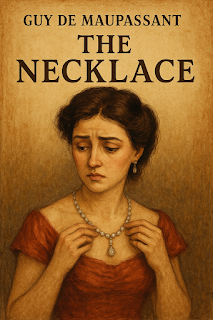Introduction
Guy de Maupassant’s “The Necklace” (La Parure, 1884) stands as one of the most iconic short stories in world literature, renowned for its brilliant use of irony and its critique of social vanity. Set in 19th-century Paris, the story follows a woman whose desire to appear wealthy and glamorous leads her to a life of unnecessary suffering. Maupassant, a master of realism, paints a vivid picture of a society obsessed with status, exposing the dangers of pride, materialism, and illusion. Through a tightly woven plot and a shocking twist ending, “The Necklace” compels readers to reflect on the true value of honesty, contentment, and the deceptive nature of appearances.
Summary of “The Necklace”
Mathilde Loisel is a young, attractive woman born into a modest family and married to a humble clerk in the Ministry of Education. Although she lives a relatively comfortable life, she is deeply unhappy and dissatisfied. She believes she was meant for a life of luxury, glamour, and social prestige, and constantly daydreams about lavish homes, fine clothing, and elegant dinners—all things far beyond her means.
"She was one of those pretty and charming girls born by a blunder of destiny into a family of clerks."
Mathilde feels trapped in a life of simplicity and is embittered by the disparity between her dreams and reality. Her husband, content with their life, does his best to please her and surprises her one day with an invitation to a grand ball hosted by the Ministry. Rather than being delighted, Mathilde is upset—she has nothing suitable to wear. To appease her, her husband sacrifices his savings to buy her a new dress.
Even after that, she laments her lack of jewelry. On her husband’s suggestion, she visits her wealthy friend Madame Forestier and borrows a beautiful diamond necklace to complete her look.
At the ball, Mathilde is radiant. She enjoys her moment of glory, admired by all. But when the night ends and they return home, she discovers that the necklace is missing.
"She searched in the folds of her dress, in the folds of her cloak, in her pockets, everywhere—but did not find it."
In a panic, the couple searches but fails to find it. They decide not to tell Madame Forestier and instead purchase a replacement necklace, valued at 36,000 francs—a huge sum for them. They borrow money from various sources, mortgaging their future, and begin a life of hardship and poverty.
For the next ten years, they live in miserable conditions. Mathilde dismisses her maid and learns to do all the household work herself. She ages prematurely, losing her beauty and elegance. Her husband takes on extra work, and together, they slowly repay the debt.
One day, after the debt is finally repaid, Mathilde sees Madame Forestier and decides to tell her the truth. She recounts how losing the necklace changed her life.
Shocked and moved, Madame Forestier finally tells her:
"Oh, my poor Mathilde! Mine was false. It was worth five hundred francs at most!"
This twist reveals the devastating irony: Mathilde’s suffering was in vain. Had she confessed the loss, she could have avoided ten years of poverty. The story ends on this tragic note, emphasizing the cost of pride and the danger of placing too much value on appearances.
Message of the Story
Maupassant delivers a sobering message: vanity and pride can lead to unnecessary suffering. Honesty, humility, and contentment are often better guides than the desire to impress others.
“The Necklace” warns against being blinded by appearances and teaches that the truth—no matter how uncomfortable—is always better faced early.
Conclusion
In “The Necklace”, Maupassant tells a deceptively simple story with a powerful moral. Through Mathilde’s downfall, he critiques materialism, vanity, and the rigid social structure of his time. The story's irony leaves a lasting impact and forces readers to question how much of our suffering stems from our own illusions.



No comments:
Post a Comment